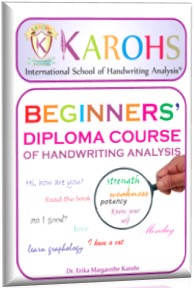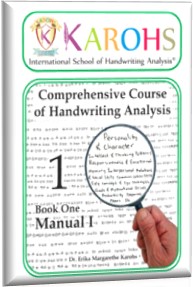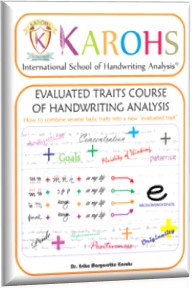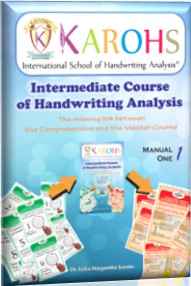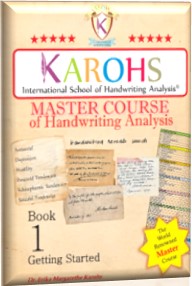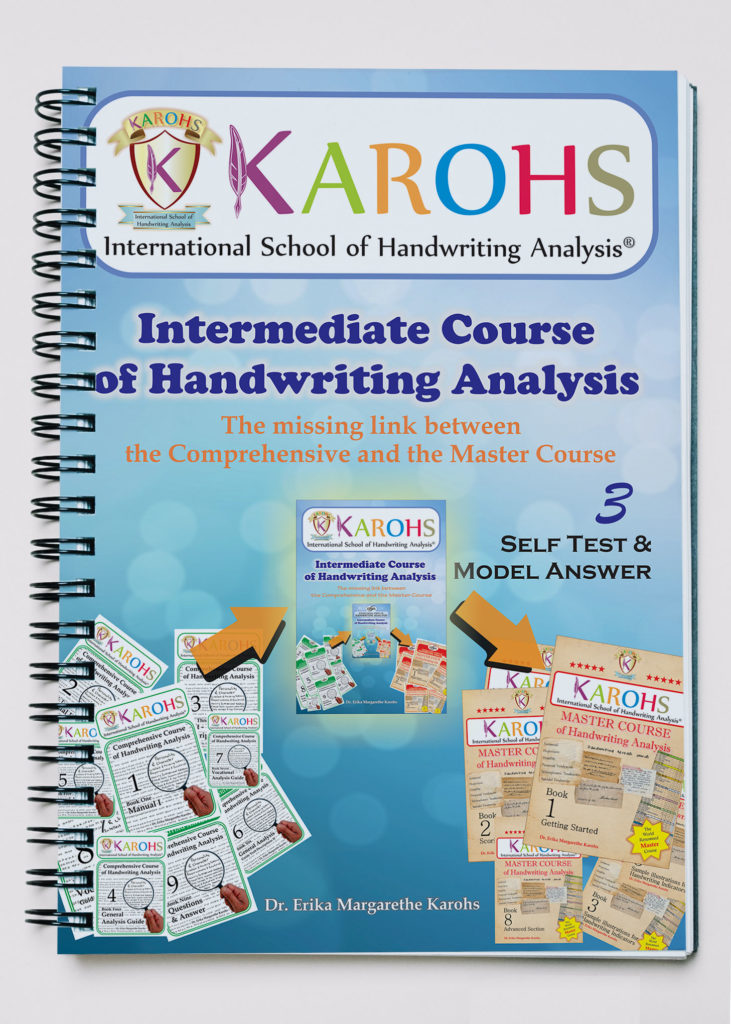
Free Article about Handwriting Analysis
From “Sunday Lessons III”
- Sunday Lesson #8: More Answers from Lesson #6
By Dr. Erika M. Karohs
Today, you will look at letters 3 and 4 of the quiz from Lesson 6. First, there will be my interpretations, followed by a step-by-step examination of the winning answer.
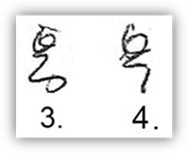
Letter # 3
INTERPRETATION OF LETTER #3
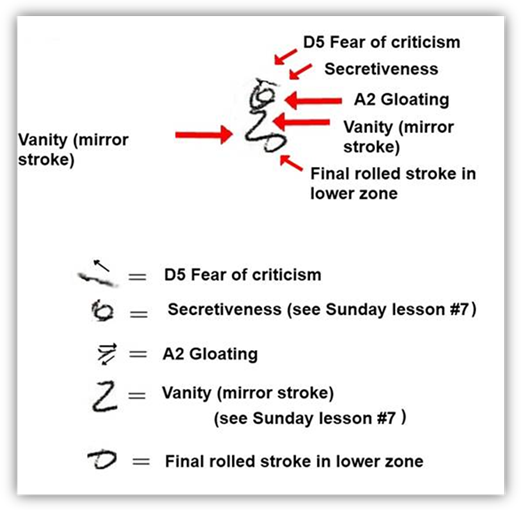
- D5 Fear of criticism and restrictions (full name of trait)
Most trait schools consider a looped d– or t-stem as sign of sensitiveness to criticism. However, the diagonal stroke is an even more significant indicator because it is an unconscious addition to letters and words and usually remains inconspicuous in the overall writing picture. The more obscure the stroke, the more intense is the meaning of the trait.
The writer is easily offended by real or imagined criticism. He is vulnerable to even unintended slights about his performance, habits, mannerisms, or beliefs. Any hint of censure makes him defensive, although he will not readily admit this, even to himself. This kind of sensitiveness is not something the writer knows about himself, it functions unconsciously.
The writer is afraid of restrictions. His fear of restrictions is so great that he hates to commit himself to any kind of event, social or otherwise, where he has to appear at a certain time. He would rather leave things “loose.” He hates to make any kind of promise that commits him definitely. This would include such social arrangements, dates, etc. He would rather “drop in” and thus leave himself a chance to avoid the engagement, if he does not feel up to it. A long-term contract, such as an engagement or getting married, would be a most difficult situation. He would feel committed without an opportunity to escape.
Important! The writer’s sensitivity to restrictions may be so great that it may extend to tight collars or tight clothing, an office without windows, a small room, elevators, or crowded places. This trait often contributes to claustrophobia.
- Secretiveness (see Sunday Lesson #7)
- A2 Gloating at and enjoying others’ misfortunes (full name of trait)
The writer suffers from unconscious hostility, intensified by personal fear, uncertainty, or lack of confidence. He resents others who are more popular, or more productive, or more gifted than he, himself, is. He is jealous of certain characteristics they may have.
When misfortune befalls one of the people he envies, he revels in malevolent delight and gloats with malicious pleasure.
- Vanity – mirror strokes (see Sunday Lesson #7)
- Final stroke rolled in lower zone
These individuals are grudge bearers who burden themselves with memories of hurts from the past. They relive these hurts over and over again as if they were happening now. They brood on events that can’t be changed and agonize over relationships that are no longer part of their lives. They continue to react in memory to past pain, and they give the person or event that caused the pain the power to hurt them over and over again. Since they approach everything from the viewpoint of the past, they are lasting enemies. They can say outwardly that they forgive but inwardly, they never forget.
Letter # 4
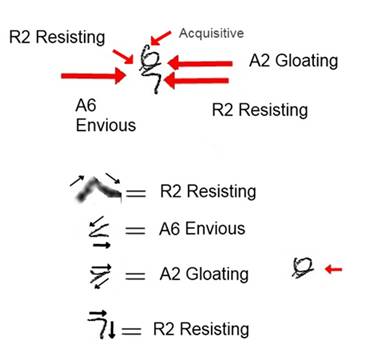
INTERPRETATION OF LETTER #4
- R2 Resisting, contrary (full name of trait
The writer is controversial, either for the sake of being contrary or because he wants to inflict his opinion on others. Being disagreeable has become his habitual response. He is a chronic nay-sayer in the belief that he is expressing a mind of his own. He imagines that he is being original in his endless opposition when in reality, he is proving exactly the opposite. He wants to be independent but succeeds only in staying tied to the voice of authority — except that he must do everything in reverse. Being contrary and contradicting are actually signs of dependence on the people he is resisting.
Resistance can be useful in many fields. For instance, professional sports figures profit from the ability to oppose others successfully. Customs clerks, armed service men and women, drug enforcement agents, auditors, criminal correction officers or law enforcement people need to resist pressures coming from others in their work. It is a help to these individuals to be able to hold on to their principles and regulations.
But resistance is too often negative because he the writer is fighting his own progress. He stands in the way of his own advancement too much of the time because he misrepresents himself to other people as a trouble maker. Being contrary and contradicting breeds resistance in others and in the end, he discourages those who would be really on his side.
Important! With tilted right angles the writer is aggressive and delights in attacking others verbally.
- Acquisitiveness
The craving for possessions is often a defense against anxiety. The need for affection is repressed to such a degree that it no longer appears on the surface while the fear of rebuff is so great that it prevents the writer from letting others know that he aches for some form of attention. Deep down, he feels so inadequate that he will not admit even to himself the necessity for it. The longing for material things then momentarily or permanently takes its place. To compensate for his lack of self-worth, the writer clings to material things which provide a measure of status or security.
The writer has the desire to acquire, to possess and gain more than he needs or deserves. He is eager to keep and to hoard. Possessions make him feel secure.
Acquisitiveness may pertain to material things, people, knowledge or property. The writer wants to own for the sake of possessing and for the security his belongings represent to him. He does not merely want to use a thing; he yearns to control what he admires.. What he is likely to desire depends upon other personality traits. (Literary interest = book collector; need for recognition = trophies, symbols of status and achievement.)
The writer probably enjoys collecting. He accumulates items that he may never have use for, but simply cannot throw away. No matter how much he piles up, he never feels really secure. When his possessions are taken from him, he feels intense anger.
The writer hates waste and it is unlikely that he will go on a spending spree. He may overeat to prevent the waste of food; he may buy bargain materials that are of inferior quality simply for the sake of a temporary saving. He combines errands to save expenditure of time and gasoline.
Organization may be a problem. There never seems to be enough room for all the things he accumulates. He may devise his own storing system and he dislikes having his possessions tampered with. He expects others to refrain from touching his belongings or rearranging them without special permission.
The writer is probably a good provider. As a manager, he will keep things in proper repair. On the other hand, he will be unwilling to loan anything and other people’s carelessness with possessions is very distressing to him.
Building security is the writer’s strong suit. He is thrifty and wants to hold on to his funds. He will not give up anything without a struggle, and that can range all the way from a beloved friend or relative to money, a title or position. He parts with what is his only to trade for the better.
The writer’s foremost concern is about tomorrow’s needs. He wants the security of knowing that all his tomorrows will be safe so he can finally relax. With one eye always on the future, he can become a miser who hoards for tomorrow and neglects to live today. He is too intent on holding on to his worldly good to really enjoy them. If his need for gain goes unchecked, greed may be the result.
To the writer, success becomes directly associated with material gains and he drives a hard bargain, as a rule. Nothing is too trivial, if the bottom line means profit. He instinctively seems to feel what will be beneficial to him. His tendency to work himself into a position of advantage can make him appear selfish to others.
The writer treasures the things he own and guards them jealously. That also includes people. He is as possessive of his family and friends as he is of material things. He tends to feel unwanted if less acquisitive individuals don’t show at least some jealousy toward him. His failure to provide his partner space can cause relationships to become difficult.
Interestingly, highly acquisitive individuals rarely become alcoholics. It just does not make sense to them to pour all their resources down the hatch, so to speak.
- A2 Gloating at and enjoying others’ misfortunes (see letter #3)
- R2 Resisting, contrary (see letter #3)
- A6 Envious, begrudging (full trait name)
The writer suffers from unconscious hostility. It is usually caused by a feeling of deprivation intensified by fear, uncertainty, or lack of confidence.
He begrudges others the advantages he desires for himself and he is envious of those who seem to get all the breaks. He is jealous of certain characteristics they may have.
The coveted items may not necessarily be beneficial to the writer, but he has deceived himself into believing that they are actually desirable ones. Often, it is not the envy of something special but a very general jealousy of everyone who is more assured, more cheerful, happier, more poised, or more secure.
The writer feels not only the need to own what others have; he also has a strong need to deprive others. He begrudges them their possessions, even if he does not want them at all. Toward friends and children the exploiting tendencies are often justified by alleging that they have an obligation toward him.
The fallacy is that even when he gets what he wants he cannot enjoy it.
And the WINNER is…
And now, the winning answer:
 It was submitted by Frik Huysamen from South Africa. Frik is a graduate of the both the Beginners Diploma Course and the Comprehensive Course. He is currently enrolled in the SSS course. He graduated from both courses with highest honors. And, as you can tell easily from his answers, he has also done much additional reading – I know that he owns nearly all of my publications.
It was submitted by Frik Huysamen from South Africa. Frik is a graduate of the both the Beginners Diploma Course and the Comprehensive Course. He is currently enrolled in the SSS course. He graduated from both courses with highest honors. And, as you can tell easily from his answers, he has also done much additional reading – I know that he owns nearly all of my publications.
The winner’s price – a six volume set “Comprehensive and Illustrated Descriptions for 215 Personality Traits for Handwriting Analysis” – has been mailed to Frik.
Congratulations, Frik! You did excellent work. I appreciate your thoughtful answers very much, and I know that everyone else will, too.
When I received Frik’s answer, I was amazed; he found more traits than I had listed. Let’s look at them one by one.
- g-1:
- THE MIDDLE ZONE:
(The middle zone part of g is a secondary indicator and may intensify what you find in the o’s and a’s.)
a) Beginning stroke, starting just beneath the apex of the middle zone:
This is an “arcaded” beginning stroke. (There is just one visible stroke remainder). The writer is defensive, inhibited and fearful and shuns close emotional contacts. He will not disclose his innermost self and he is very reticent about matters of a personal nature. He adapts to his environment in a self-protective manner; however, his adaptation lacks spontaneity. It is a sham because security is extremely important to him
Comment by Erika: Frik, you are correct. You must have done real detective work on that one. The arcaded stroke is only noticeable by the tiny initial remainder of the stroke. I had to enlarge it considerably to see this. The arcades stroke in letter 1 moves from right to left.
Sample for arcaded beginning stroke:
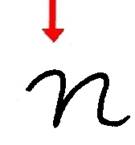
b) The oval is angular at the baseline:
This connotes anxiety in interpersonal relationships. The writer suffers tension in the emotional and social sphere. He feels much hostility resulting in the desire to humiliate others. He is easily offended and sometimes vindictive in personal matters.
Comment by Erika: Frik, again you are correct. This coincides with the trait “Final rolled stroke in lower zone” in letter #3
c) Secretiveness:
See the loop that is formed by the upstroke, from the baseline to the apex of the middle zone and by the following downstroke, to the point where it first crosses the writing line on the right side of the oval. This is an “inside” loop. The relevant trait is secretiveness. The writer has the disposition to keep or make secrets, especially of his own concerns. Secretiveness is often used defensively. Since the writer keeps problems bottled up inside, tension and anxiety can build up to unhealthful levels.
Comment by Erika: Frik, you are correct. Secretiveness occurs repeatedly and intensified by the “coverstrokes.”
d) Break in writing line:
See the top part of the loop that falls outside the circle. Broken lines are breaks and cracks in the ductus (line of writing) itself. They are evidence of a physio-pathological condition, which may be either temporary or permanent in the writer. If they appear only in the middle zone, they are usually related to a nervous disturbance.
Comment by Erika: To be absolutely sure about this, I would want to see the original. I enlarged the writing many times and there seems to be a break in letter #1 where you describe it, Frik. But there are also broken strokes in the initial part of letter #2 and the final part of letter #3. However, there are several possibilities for that. The writer could have physical difficulties producing a smooth upstroke (health?); he may have been writing on a rough surface; he may have had a defective pen; he may be a very fast writer producing “airstrokes.” (Airstrokes will be explained in the next Sunday lesson.) So, for this indicator, I would not come to a conclusion without seeing the original.
e) Coverstrokes:
The first coverstroke is where the upstroke of the first loop meets the “initial stroke”, covering it partially before it turns down and right-wards to complete the loop of secretiveness. The second one is on the left side of the oval where the downstroke of the outside loop crosses the oval, then turns sharp down and right-wards, covering the “oval line” from the crossing-point up to the angle at the bottom of the oval.
Cover strokes have the effect of hiding a stroke that is already there. The writer lacks assurance in interpersonal relationships. He is timid, self-conscious and insecure and displays more than average amounts of defensiveness. As a result, he limits his field of social activity and withdraws from unfamiliar people and relationships.
Comment by Erika: Correct, cover strokes occur repeatedly throughout the letters. See also my explanation in Sunday lesson #7.
f) Withdrawal:
Graphic indicator: Left slanted writing (see the middle zone upslant of g-1).
The writer withdraws physically or mentally from other people or from situations that arouse a sense of threat. The writer is emotionally withdrawn and isolated. He recoils from involvement and is suspicious of relationships that become too intimate. He is afraid of life itself and of the future.
Comment by Erika: Frik, do you mean the little upstroke toward the left in the final part of letter #1? For this too I would like to see the original. I could not really tell whether this is a triangular formation or what it is. I don’t like to interpret anything that I am not absolutely sure of.
- THE LOWER ZONE:
g) Downstroke curved:
The downstroke is curved because of directional pressure, an invisible pressure coming out of two directions of the writing field (in this case). The cause of directional pressure is strong fear which is affecting the writer emotionally. It creates a feeling of hopelessness but, at the same time, an unconscious resistance of giving in to the desperation. The writer cannot use his imagination productively. He fails to learn from past experiences.
Comment by Erika: The downstrokes are courved in all 4 letters, but this does not constitute “directional pressure.” (Directional pressure will also be explained in an umcoming Sunday Lesson.) For directional pressure to be present, the whole part of one zone has to be “bent” like this:

It is as if a fist had hit the letter in one zone and the whole zonal section is caved in. For the meaning of the curved lower zone part of the letters, see my explanations.
h) Final stroke (double) ticked:
In this relatively slow writing the two ticks in the end-stroke are an indication of irritability, related to the lower zone and what it symbolizes.
Comment by Erika: Please see my answer under g)
i) The lower zone extension pulls to the right:
A lower zone that pulls strongly to the right is usually made by those who rebel against male authority.
Comment by Erika: Frik, I disagree with this one because the whole letter g leans slightly backwards (leftwards). We speak of the “lower zone pulling right” only if the downstroke moves right in opposition to the middle zone slant (see example).
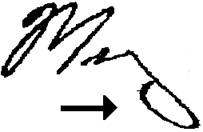
With the lower zone pulling right in opposition to the middle zone slant, the writer suffers from inner conflicts and experiences discord between his feelings and his behavior. He feels sexually deficient and may have resigned himself to an inadequate sex life. The subsequent frustration may be the root of his aggressiveness. He brings too many situations to the point of conflict and fights more often than he needs to. He wastes time and energy defending issues that need no defense. Sometimes, when he feels pressured, he will go out of his way to pick a fight.
This does not apply in to our four samples.
j) Lower zone length short (ratio)
The writer has restricted energy for physical work and sexual activities. It has a negative effect on optimism, enthusiasm and on motivation.
Comment by Erika: Yes, Frik, this measurement applies to letters 1, 3 and 4.(lower zone ratio to middle zone 1.51 to 2. For letter 2, lower zone length is copybook (ratio 2.01 – 2.5).
Your description is absolutely correct – as far as the lower zone goes. And since I have given you only those four letters there was no other conclusion you could come too. Let me add at this point that the person has a good deal upper zone emphasis (I have seen the writing). Would you then agree that the following should be added:
The writer performs best intellectually. She (I assume it is a “she”) does not naturally enjoy physical activity. She is inclined to express herself in terms of mental rather than physical work, most often. She has mental endurance and will stay with mental work until it is done.
Within the writer, there exists a close bond between sexuality and intellect. She may have less interest in frequent sexual activity because she wants quality instead of quantity; she needs optimum conditions to arouse the physical in her. She needs to prepare her mind as to what she will be doing. Sexual fulfillment comes only with mental satisfaction and it takes mental stimulation to release a physical response.
k) Ductus corrugation:
The border of the ductus is feathery. It reveals the writer’s degree of instinctual physical control and to what degree the writer keeps his sensual responses under control. The fuzzy, feathery borders symbolize lack of restraint.
Comment by Erika: Frik, I am hesitant to make assessments about the ductus (writing line) without seeing the original. This particular writing has been scanned and copied and re-copied which does affect line quality. Whenever I have to evaluate the ductus, I ask for the original.
![]()
- g-2:
- THE MIDDLE ZONE:
l) Resentment:
Initial strokes are inflexible from baseline or below. The writer has a resentful, defensive attitude. He is guided by past experiences and biased because of subjective memories. His main concern is how he, himself, is feeling most of the time. He easily feels taken advantage of by others. The initial stroke (airstroke) is slightly rounded. This indicates that the writer is still resistant but expresses himself in a lighter, less antagonistic manner.
Comment by Erika: Correct. See also my explanations in Sunday lesson #7.
m) Airstroke:
Airstrokes are connecting lines from one zone to another in which the writing instrument has been slightly lifted off the paper. Both stroke remainders must be visible and point towards each other. See the initial upstroke remainder below the baseline with the hairline of the airstroke moving upwards to the second stroke remainder near the apex of the middle zone.
These frictionless immaterial lines represent the intellectual. They manifest mental perspicuity, associative skills, and logical thinking ability. They are the kind of people who dislike friction in their work and interpersonal relationships. Depending on the degree of airstrokes the writer may be flexible or may be in a habit of taking the easy way out.
Comment by Erika: I am inclined to agree with you, but please, see my explanation under d).
n) Deceptiveness:
Graphic indicator: Oval structures with double loops. See the double loops in the oval of g-2. The writer is defensive and tries to conceal certain personal concerns. He communicates only in the most indirect manner. Under stress, he is likely to manipulate, blame others, lie or resort to silence to evade the truth. The writer’s evasiveness is often infantile in character. It represents a defense the writer has carried over from childhood into his adult life.
Comment by Erika: Yes, you are correct. See also my explanation in Sunday Lesson #7, Letter #1.
o) Lovingly, kind and benevolent:
See the left tending expanded curve, starting near the point where the diagonal stroke crosses on the left side of the oval.
The writer has a disposition of heart which inclines him to think favourably of his fellow men and to do them good. His heart beats with selfless concern when the suffering and privation of another person arouses his compassion. Then he never holds back with time, resources and effort. He will share willingly when someone he likes is in real need.
Comment by Erika: I disagree with that one, Frik. An expanded double curve (this will be subject of an upcoming Sunday Lesson) has to be like a perfectly rounded half of a circle. None of the curves or circular strokes in the four letters are so perfectly rounded.

p) Gloating at and enjoying others’ misfortunes:
Indicator: An acute angle formed by a right tending diagonal stroke moving right and -downwards and a right tending straight stroke moving horizontally from right to left.
The writer suffers from unconscious hostility, intensified by personal fear, uncertainty, or lack of confidence. He resents others who are more popular, or more productive, or more gifted than himself. He is jealous of certain characteristics they may have. When misfortune befalls one of the people he envies, he revels in malevolent delight and gloats with malicious pleasure.
Comment by Erika: You are perfectly correct. See also my explanations for letters #3 and #4.
* Lower zone length copybook (ratio)
* See also sections (e & f).
Comment by Erika: See my explanations under j).
- THE LOWER ZONE:
q) Tenacity:
Graphic indicator: Final hooks on letters or words. See the hook on the end of the final stroke.
The writer clings to his possessions or that which he has gained. He may cling to his opinions as well as to material things. More than any other trait, tenacity assures success. Given a task, the writer hangs on to his objectives. Since he is equally tenacious with people, it would be difficult to break off a relationship with this individual.
* See also sections (g, i, k)
Comment by Erika: Very well observed. See also my explanations in Sunday lesson #7.
- g-3
- THE MIDDLE ZONE:
r) Protection stroke:
See the covering stroke above the oval-part of the g that looks like a roof top. Horizontal strokes above the middle zone originate in the need for self-protection. Their purpose is to figuratively prevent the expansion of the writing upward as well as to protect and cover the structure below. As a rule, such writers are defensive when there is a threat.
Comment by Erika: See my explanation in this Sunday Lesson, D5, Fear of criticism.
s) Vindictive, retaliatory, spiteful, unforgiving and vengeful:
See the acute angle in the middle zone, formed by a left tending straight stroke following by a left tending diagonal stroke.
The writer’s self-esteem has been wounded by humiliation and as a result, he has become vindictive. By threatening others the writer shows that he is fighting an unconscious fear of being humiliated again. He feels that if he is able to do to others what he fears may be done to him, he no longer has to be afraid.
Comment by Erika: Frik, this is an A2 acute angle “Gloating” because of the direction it moves in. The A5 “Vindictive” angle moves in the opposite direction.
t) Responsiveness:
See the middle zone upslant which is slightly right.
The writer is sociable in interpersonal relationships. He opens up and demonstrates the feelings he has for others without being impulsive. He is able to show that he cares without feeling vulnerable.
Comment by Erika: Frik, for this writing, I would try to do the slant measurements predominantly with the thinking letters m, n. and also h, l, etc. These convoluted ovals are not the ideal letters to measure.
* See also section (c, e)
- THE LOWER ZONE:
u) Clannishness:
See the small rounded loop at the bottom of lower zone downstroke. Small rounded Clannishness is indicative of basic insecurities resulting from an unhappy social environment. The writer has a tendency to associate closely, to the exclusion of others, with chosen members of a special group.
* See also sections (g, i, j, k).
Comment by Erika: Frik, I interpreted this little loop in letter #3 as a rolled stroke. It may be debatable. I felt it was too large for a clannishness loop.
- LOWER ZONE VERSUS MIDDLE ZONE:
v) Conflict:
The slant between the middle zone and the lower zone is opposing.
This is evidence of conflict with subsequent frustration in the physical and sexual sphere.
Comment by Erika: I don’t see it like that. I find that the whole letters lean in the same direction. To tell you the truth, they are really hard to measure.
- g-4
- THE MIDDLE ZONE:
w) Dry spots on the ductus:
See the dry spot on the apex of the initial stroke’s (arcade). The dry spot is only on one side of the ductus and thus not balanced. An indentation in the ductus that is devoid of ink is a very serious indicator. It reveals the writer’s extremely low state of energy. This condition may result from ill health, stress, or exhaustion.
* See also sections (c, e, l, m, p, t,).
Comment by Erika: A dry spot occurs only at the very beginning of a stroke.
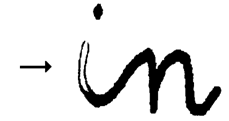
I can’t see that this could be applied to the samples. The beginning strokes in letters 1, 2, and 4 are actually darker than the writing. Letter #3 is too blurred to really make a determination.
- THE LOWER ZONE:
* Dry spot on the ductus:
See the dry spot on the right tending curve in the lower zone.
See also the section at (w).
Comment by Erika: See my last comment.
x) Final dot:
See the dot at the end of final lower zone stroke.
Final dots convey that for some reason the writer often needs to pause during the writing process as well as when performing physical activities.
Comment by Erika: That is correct.
* See also sections (g, i, j, k).
If you found these letters in a handwriting, what would you tell your client?
I would tell her that her handwriting shows that she has very special qualities. I will talk to her about her mental perspicuity, associative skills and logical thinking; that she is a good friend; good listener; can keep secrets; can be very loving, kind and benevolent and never holds back with time, resources and effort when someone she likes is in real need.
Her handwriting also shows that she experienced deep humiliation as a child. She often felt been taken advantage of.
To survive as child she had to protect herself emotionally. Early in her childhood she gradually (consciously and unconsciously) learned various defense mechanisms to protect her from anxiety, loss of self-esteem and other fears.
I will explain to her that she has carried many of those defense mechanisms over from childhood into her adult life. Her main defense is to withdraw physically or mentally from other people or from situations that arouse a sense of threat. When she cannot do that and are compelled to interact with others, she protects herself by being secretive, concealing certain personal concerns and sometimes just goes with the flow. When she experience humiliation from someone and her self-esteem has been wounded she may become vindictive and thereby fighting her unconscious fear of being humiliated again. In such cases she may even enjoy the others’ misfortune.
Since she keeps problems bottled up inside, tension and anxiety can build up to unhealthy levels. Most importantly, she uses much of these energies to maintain the defense mechanisms and, consequently, has less stamina for more productive activities. She may suffer from chronic fatigue. Because of the unconscious preoccupation with her defensive struggles, she may find it difficult to concentrate on conscious tasks.
I will remind her of her special qualities; qualities that are very much neglected and not coming to their full potential. Those qualities are overshadowed by past hurtful experiences and by her defense systems. There is no energy left for them to shine. I will strongly suggest that she seriously consider an appointment with a professional therapist to discuss my verbal handwriting report. I will recommend a specific, very competent female therapist.
Comment:
Frik, I agree with almost everything, except for the first paragraph (because benevolence is not one of her traits) and we don’t have evidence of the thinking letters. I very much like the compassionate, nurturing and helpful tone of your letter which is much easier for a client to accept than criticism or disparagement.
Note to Frik:
Thank you for generously devoting your time and your knowledge to our Quiz. You did a great job and you gave us an excellent example of describing what you see. I hope that it was a learning experience for you and for everyone else.
Note to everyone:
I am inviting everyone to write your own letter to this person – as a handwriting analyst to a client. Send your answer to me at emkarohs@gmail.com .
My sample letter will be published with Sunday Lesson #9.
Sources:
If you are interested to learn about diagonal strokes, acute angles, right angles etc., you can find it all in the book “Personality Traits At A Glance, Traits in Handwriting You Should Know But Probably Don’t”.
This book is available at my website https://karohs.com/books/
Printed version only $32.00. You will receive 10% discount, if you write into the “Comments” section of the Order Form “Article Sunday Lesson #8″.
Best regards,
Erika M. Karohs, Ph. D., Ed. D.
Note:
Information used in the Sunday lesson is from the following sources:
o *Acute angles:
Erika M. Karohs: Personality Traits At A Glance, Traits in Handwriting You Should Know, But Probably Don’t.
Information in this book is not available from anywhere else. It has been translated, including the trait names, by Dr. Karohs, and it is copyrighted material. If you come across this information in seminars by one of the major handwriting analysis schools, as I have, and they are touting this material as their discovery, be advised that the information is stolen from me.
o **Horizontal ellipsis
Erika Karohs: Personality Traits At A Glance, Traits in Handwriting You Should Know, But Probably Don’t. Volume 2 (unpublished manuscript – not available yet).
o Vanity in mirror strokes:
Erika M. Karohs: “Handwriting Analysts’ Companion (4 volumes).
o Trait descriptions:
“Comprehensive and Illustrated Description for 215 Personality Traits” (6 volumes).
These books are available at
https://karohs.com/books/
I hope you are enjoying this exercise and feel that you are learning from it.
Best regards,
Erika M. Karohs, Ph. D., Ed. D.
I hope you enjoy “Sunday Lessons Series III”. If you have any questions or would like to recommend topics, please feel free to email me at info@karohs.com
See detail courses programs (click the image below):
Copyright © 2018 the KAROHS International School of Handwriting Analysis®. All rights reserved.
No image or portion of this website may be copied or reproduced without written permission.
Intermediate Course of Handwriting Analysis
The Intermediate Course provides the link between the Comprehensive Course and the Master’s Course of Handwriting Analysis and is intended for students with some prior knowledge of handwriting analysis. It uses the integrated trait stroke/holistic approach but does not go into as much depth as the Master Course of Handwriting Analysis.
The course is designed in a logical sequence so that by simply following the instructions, the analyst learns to procude an accurate analysis every time.
With the Intermediate Course analysts no longer have to search for appropriate descriptions and phrases; they have to do no painful report writing of their own, all definitions are provided in the manual.
Course materials:
- The course comes with the following materials:
- Ten lessons in a sturdy manual
- Ten self tests, one test per lesson
- Model answers for all parts of the self tests
- Worksheets
HOME
Click here to back to KAROHS Home Page
COURSE
Click here to see our Course Programs
BOOKS
Click here to see our Books Store
Copyright © 2018 the KAROHS International School of Handwriting Analysis®. All rights reserved.
No image or portion of this website may be copied or reproduced without written permission.

